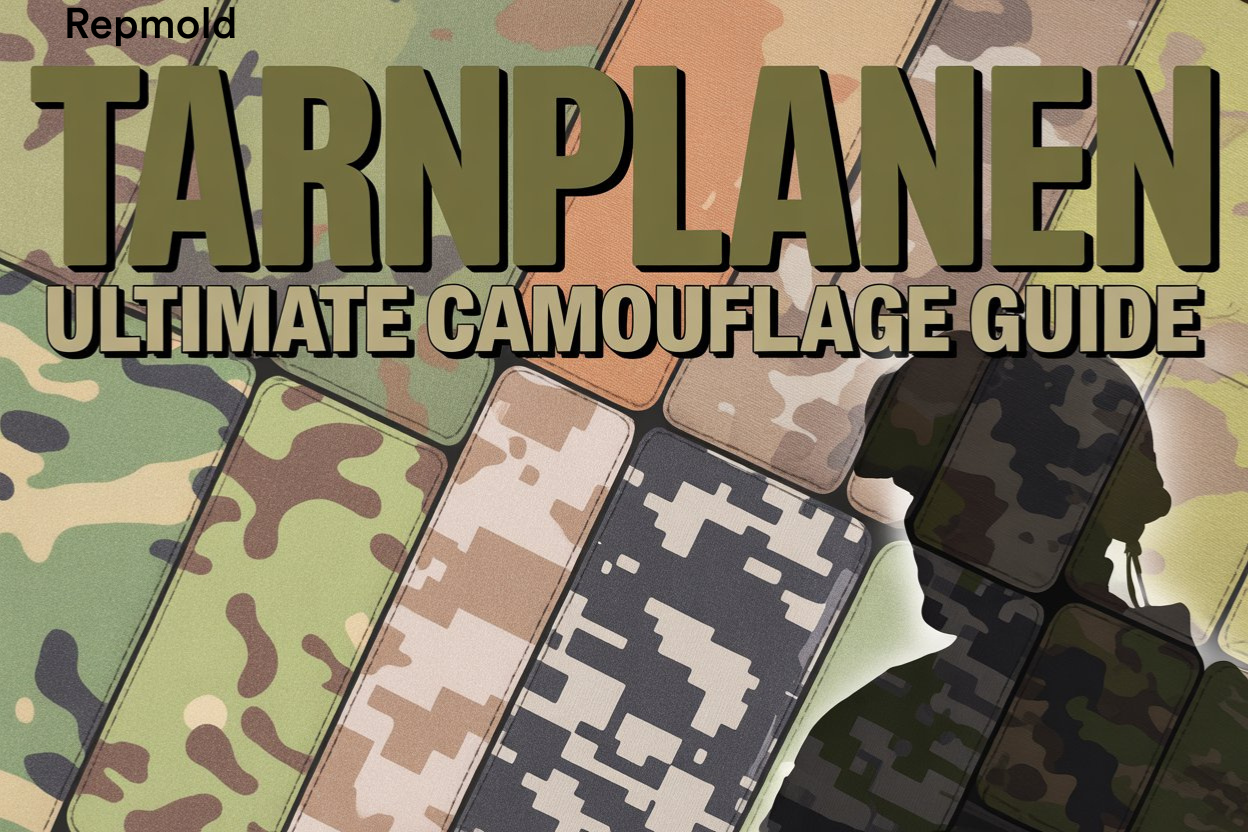Introduction
Tarnplanen is a type of camouflage tarp used to hide and protect objects. Its name comes from German: “Tarn” means camouflage, and “Planen” means tarpaulin or cover. Essentially, it is a durable, waterproof sheet designed to blend seamlessly into surroundings.
The versatility of tarnplanen is remarkable. In the military, it conceals vehicles, equipment, and soldiers from view. Outdoors, campers and hikers use it for shelter or ground protection. Survivalists rely on it to stay safe in harsh conditions. Wildlife photographers use it to observe animals without being noticed.
Understanding tarnplanen is important today. Modern outdoor activities, tactical missions, and wildlife observation all benefit from effective concealment. Moreover, weather protection and portable shelter make it a practical tool for emergencies. By knowing how to use tarnplanen, you gain safety, comfort, and strategic advantage wherever you go.
What is Tarnplanen?
The term “tarnplanen” comes from German origins. “Tarn” means camouflage, and “Planen” means tarp or cover. Essentially, it refers to a tarp designed for concealment and protection.
Tarnplanen is a durable and waterproof fabric. It blends into natural or urban surroundings easily. Many designs include patterns that help hide people, equipment, or shelters.
Key characteristics make tarnplanen highly versatile. First, it is lightweight, allowing easy carrying during outdoor activities. Second, it is strong and tear-resistant, ensuring long-lasting use. Finally, its flexible design allows multiple applications, from tactical missions to camping trips.
Overall, tarnplanen is a practical tool. Its combination of camouflage, durability, and portability makes it essential for military, outdoor, and survival use. Understanding these basics helps readers appreciate its value in modern settings.
History and Evolution of Tarnplanen
Tarnplanen has its roots in military history. It was first widely used during World War I. Soldiers relied on it to hide equipment, vehicles, and positions from enemies.
During World War II, tarnplanen became even more advanced. Camouflage patterns evolved to match forests, deserts, and other terrains. These designs were inspired by observing nature and animal behaviors. Transitioning from simple fabrics, new materials improved durability and weather resistance.
Over time, technology further shaped tarnplanen’s development. Digital patterns emerged to confuse both human eyes and sensors. Modern fabrics are lighter, stronger, and more versatile than ever before.
Today, tarnplanen is no longer limited to military use. Outdoor enthusiasts, hunters, photographers, and survivalists all benefit from it. It adapts to camping shelters, emergency protection, and wildlife observation.
In short, tarnplanen has evolved from a simple military tarp to a multipurpose tool. Its history reflects innovation, adaptability, and ongoing relevance in many fields.
Why Tarnplanen is Essential for Outdoor and Tactical Use
Tarnplanen provides excellent weather protection in any outdoor environment. It shields against rain, keeping gear and people dry. It also blocks harsh sunlight, preventing overheating and sun damage. In addition, it reduces the impact of strong winds on tents or equipment.
Concealment is another key benefit. Tarnplanen blends seamlessly into surroundings, hiding humans, shelters, and tools from view. Its camouflage patterns break up outlines, making detection by animals or enemies difficult. This feature is crucial for survival, hunting, or tactical operations.
Moreover, tarnplanen acts as a portable shelter. Lightweight and compact, it is easy to carry during long hikes or missions. Setup is quick, allowing immediate protection in emergencies or sudden weather changes.
Overall, tarnplanen combines protection, concealment, and portability. Whether for military, outdoor adventures, or survival, it is an indispensable tool that enhances safety and efficiency.
Real-Life Applications of Tarnplanen
Tarnplanen serves many practical purposes in real-life situations. In military and tactical operations, it hides troops, vehicles, and observation posts. Its camouflage patterns make detection by enemies difficult. Moreover, it helps soldiers stay protected from environmental conditions during missions.
For camping and outdoor survival, tarnplanen is extremely useful. Campers use it to build temporary shelters or lean-tos quickly. It also keeps sleeping bags, gear, and supplies dry in rain or damp conditions. In emergencies, it provides a portable refuge for safety and comfort.
Hunters and wildlife photographers also rely on tarnplanen. It allows them to stay unseen by animals while observing natural behavior. The tarp reduces human scent and breaks up visible outlines. Consequently, it enables closer observation without disturbing wildlife, improving success and experiences.
Overall, tarnplanen is versatile and essential across multiple scenarios. Its ability to conceal, protect, and provide shelter makes it a trusted tool in military, outdoor, and wildlife settings.
Materials & Features that Make Tarnplanen Effective
Tarnplanen is made from a variety of durable fabrics. Common options include polyester, nylon, canvas, and cotton blends. Each material offers different strengths, such as tear resistance and flexibility.
Many tarnplanen are coated with PU or PVC. These coatings improve water resistance and prevent moisture from soaking in. As a result, gear and shelters stay dry in rain or damp conditions.
Reinforced grommets are another important feature. Metal-ring holes along the edges allow secure tying with ropes, cords, or stakes. This ensures the tarp stays in place even during strong winds.
When choosing tarnplanen, balance lightweight design with durability. Lightweight tarps are easy to carry, but heavier fabrics may offer more protection and longevity. Considering both factors ensures practical and reliable use in any environment.
Overall, the combination of strong materials, waterproof coatings, and reinforced features makes tarnplanen effective. These characteristics allow users to rely on it for outdoor, tactical, and survival situations.
Choosing the Right Camouflage Pattern
Tarnplanen comes in several popular camouflage patterns. Woodland camo features green, brown, and black tones. It works best in forests and leafy environments. Desert camo uses tan and beige shades, ideal for dry, sandy terrain. Urban camo includes gray and black patterns, suitable for city or concrete areas. Digital camo uses pixelated designs to confuse both eyes and sensors.
Selecting the right pattern depends on your environment. First, observe the terrain and natural colors. Then, match the tarp to surroundings for maximum concealment. Avoid patterns that clash with the area, as they reduce effectiveness.
Camouflage patterns enhance stealth significantly. They break up shapes and outlines, making objects or people less noticeable. Using the right pattern helps you stay hidden from wildlife, other observers, or enemies. Additionally, layering natural elements like branches or leaves can further improve blending.
Overall, choosing an appropriate camouflage pattern ensures your tarnplanen performs effectively. Proper selection improves concealment, increases safety, and maximizes tactical or outdoor advantages.
How to Use Tarnplanen Like a Pro
The first step is matching the tarp to your environment. Choose colors and patterns that blend naturally with surroundings. This ensures maximum concealment and reduces visibility to observers or wildlife.
Next, add natural elements like branches, leaves, or dirt. Layering these items over edges and corners breaks outlines and improves stealth. This simple technique makes the tarp appear as part of the environment.
Anchoring the tarp securely is crucial. Use ropes, cords, or stakes through reinforced grommets. A well-secured tarp prevents flapping in wind and exposure that can give away your position.
Avoid common mistakes to maintain effectiveness. Over-camouflaging with too many elements can look unnatural. Improper setup, loose corners, or gaps can also compromise concealment. Practice proper deployment to ensure the best results.
By following these tips, anyone can use tarnplanen like a professional. Proper setup enhances protection, stealth, and overall efficiency in outdoor or tactical scenarios.
Legal and Ethical Considerations
Before using tarnplanen, it is important to understand the laws. Some camouflage patterns, especially military designs, are restricted in certain areas. Ownership or use may require permissions to avoid legal issues.
Hunting and park regulations must also be followed. Many parks prohibit certain types of camouflaged gear to protect wildlife and visitors. Hunters should check local laws to ensure compliance with seasonal and area rules.
Respecting wildlife and natural habitats is equally important. Avoid disturbing animals or damaging plants when setting up a tarp. Use existing clearings or non-sensitive areas to minimize environmental impact.
Overall, using tarnplanen responsibly ensures safety, legality, and ethical practice. Being aware of rules and respecting nature preserves both the environment and your credibility as an outdoor enthusiast.
Buying Guide : What to Look for in Tarnplanen
When buying tarnplanen, material strength is a top priority. Choose fabrics that are tear-resistant and durable for long-term use. Weather resistance is equally important; look for waterproof coatings to protect against rain and moisture.
Size and portability should match your needs. Smaller tarps are easier to carry on hikes or missions. Larger tarps provide more coverage but can be heavier and bulkier to transport.
Check grommet spacing and setup options carefully. Reinforced grommets make tying and anchoring easier. Proper spacing ensures the tarp stays secure in wind or adverse weather.
Finally, buy from reputable sources. Military surplus stores, trusted outdoor brands, and verified online retailers offer quality products. Reading reviews and checking specifications ensures you get reliable, long-lasting tarnplanen.
Overall, considering material, size, setup features, and seller reliability helps you choose the best tarnplanen. These factors guarantee practicality, durability, and effective camouflage wherever you use it.
Future and Advanced Uses of Tarnplanen
Tarnplanen continues to evolve with new materials and advanced technology. Adaptive camouflage fabrics can change color or pattern based on surroundings. This innovation enhances concealment in diverse environments.
Beyond military use, tarnplanen is finding new applications. It helps in disaster relief by providing temporary shelters quickly. In film production, it creates realistic hidden sets or props. Wildlife protection also benefits as researchers observe animals without disturbance.
Future innovations may include smart fabrics integrated with sensors. These materials could adjust to light, weather, or movement automatically. Lightweight, durable, and multifunctional designs will make tarnplanen even more practical.
Overall, the future of tarnplanen promises greater versatility and effectiveness. Advances in technology and materials will expand its role in outdoor, tactical, and professional uses.
Conclusion
Tarnplanen offers key benefits: concealment, protection, and remarkable versatility. It keeps gear and people safe while blending into surroundings.
Using tarnplanen also builds confidence. Knowing you are hidden and prepared enhances both comfort and efficiency outdoors. Its practicality makes it ideal for camping, tactical missions, hunting, or wildlife observation.
Investing in a quality tarnplanen is worthwhile. Explore different patterns, materials, and sizes to suit your needs. With proper use, it becomes an essential tool for outdoor adventures, survival situations, and professional applications.
Overall, tarnplanen is more than just a tarp. It is a reliable companion that enhances safety, stealth, and success in any environment.

